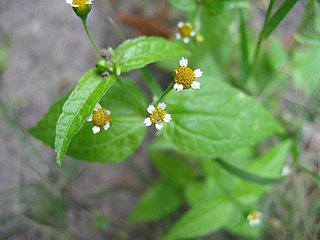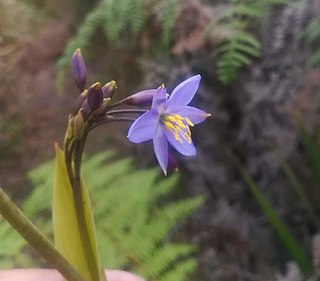
Trillium is a genus of about fifty flowering plant species in the family Melanthiaceae. Trillium species are native to temperate regions of North America and Asia, with the greatest diversity of species found in the southern Appalachian Mountains in the southeastern United States.

Botrychium is a genus of ferns, seedless vascular plants in the family Ophioglossaceae. Botrychium species are known as moonworts. They are small, with fleshy roots, and reproduce by spores shed into the air. One part of the leaf, the trophophore, is sterile and fernlike; the other, the sporophore, is fertile and carries the clusters of sporangia or spore cases. Some species only occasionally emerge above ground and gain most of their nourishment from an association with mycorrhizal fungi.

Calocedrus, the incense cedar, is a genus of coniferous trees in the cypress family Cupressaceae first described as a genus in 1873. It is native to eastern Asia and western North America. The generic name Calocedrus means "beautiful cedar".

Peter Hamilton Raven is an American botanist and environmentalist, notable as the longtime director, now President Emeritus, of the Missouri Botanical Garden.

Dipteryx is a genus containing a number of species of large trees and possibly shrubs. It belongs to the "papilionoid" subfamily – Faboideae – of the family Fabaceae. This genus is native to South and Central America and the Caribbean. Formerly, the related genus Taralea was included in Dipteryx.

Coeloglossum is a genus of flowering plants in the orchid family Orchidaceae. It has long been considered to have only one species, Coeloglossum viride, the frog orchid. Some recent classifications regard Coeloglossum as part of the larger genus, Dactylorhiza, so that C. viride becomes Dactylorhiza viridis. Other sources continue to keep Coeloglossum viride separate.

Heliopsis is a genus of herbaceous flowering plants in the family Asteraceae, native to dry prairies in North and South America. The sunflower-like composite flowerheads are usually yellow, up to 8 cm (3 in) in diameter, and are borne in summer. Species are commonly called ox-eye or oxeye.

Galinsoga parviflora is a herbaceous plant in the Asteraceae (daisy) family. It has several common names including guasca (Colombia), pacpa yuyo, paco yuyo and waskha (Peru), burrionera (Ecuador), albahaca silvestre and saetilla (Argentina), mielcilla, piojito, galinsoga, gallant soldier,quickweed, and potato weed.

Dipteryx charapilla is a little-known species of flowering plant in the family Fabaceae, a large to mid-sized tree growing along rivers in the rainforests of Brazil. and Peru.
Julian Alfred Steyermark was a Venezuelan American botanist. His focus was on New World vegetation, and he specialized in the family Rubiaceae.

Asplenium viride is a species of fern known as the green spleenwort because of its green stipes and rachides. This feature easily distinguishes it from the very similar-looking maidenhair spleenwort, Asplenium trichomanes.
Leslie Andrew Garay, born Garay László András, was an American botanist. He was the curator of the Oakes Ames Orchid Herbarium at Harvard University, where he succeeded Charles Schweinfurth in 1958. In 1957 he was awarded a Guggenheim Fellowship.
Passiflora viridescens is a plant species native to Perú and Ecuador.

Excremis is a genus of herbs in the family Asphodelaceae, first described as a genus in 1829. There are only one known species, Excremis coarctata, native to South America.
Aratitiyopea is a monotypic genus of flowering plants, in the family Xyridaceae containing the single species Aratitiyopea lopezii. The genus was erected and described in 1984. This species is native to northern South America.

Evodianthus is a genus of plants first described as a genus in 1857. It contains only one known species, Evodianthus funifer, native to Trinidad & Tobago, Central America and northern South America.
Trillium viride, commonly called the wood wakerobin, is a species of flowering plant in the family Melanthiaceae. It is found in the central United States, in certain parts of Missouri and Illinois. The specific epithet viride means "youthful" or "fresh-green", an apparent reference to the color of the plant's flower petals. For this reason, it is also called the green trillium, not to be confused with other green-flowered trilliums such as T. viridescens and the green form of T. sessile, both of which are found in Missouri.

Dr. Charlotte M. Taylor is a botanist and professor specialising in taxonomy and conservation. She works with the large plant family Rubiaceae, particularly found in the American tropics and in the tribes Palicoureeae and Psychotrieae. This plant family is an economically important group, as it includes plant species used to make coffee and quinine. Taylor also conducts work related to the floristics of Rubiaceae and morphological radiations of the group. Taylor has collected plant samples from many countries across the globe, including Chile, Colombia, Costa Rica, Panama, and the United States of America, and has named many new species known to science from these regions. As of 2015, Taylor has authored 278 land plant species' names, the seventh-highest number of such names authored by any female scientist.

Dipteryx micrantha is a tropical flowering plant, a giant tree in the Faboideae subfamily of the bean family Fabaceae. It is a dominant emergent tree in parts of the rainforests of Bolivia, Brazil, Colombia, Ecuador and Peru. In the international timber market, this species is traded under the name cumaru. It furnishes a dense, hard, beautiful reddish timber which has become a popular import in the 2010s for use in parquet. The ornamental bunches of lilac pink flowers high in the canopy eventually develop into a mass of large fruit pods, which are an important food for many native animals during the dry season. The fruit contains a single oily seed which is edible, although these seeds are not exploited as a commercial product.

World Flora Online is an Internet-based compendium of the world's plant species.














